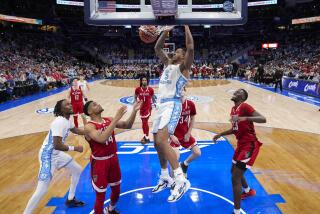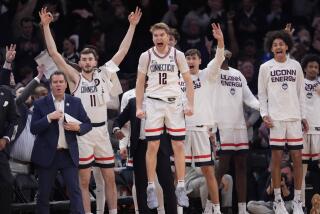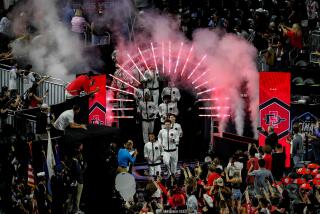Gonzaga Should Be Used to Upsets by Now
The cameras were there to record the celebration.
They got little but a cold, hard stare and a shift in his seat from Gonzaga Coach Mark Few.
He had just seen the NCAA selection committee try to wrest the men’s basketball tournament back from the little guys.
Gonzaga, ranked No. 6 in the country and a veteran of the last three Sweet 16s, hoped to be seeded No. 2 or--somewhat more realistically--No. 3 in its region.
Instead, the ‘Zags (29-3) are sixth in the power-packed West--and could face Arizona, which won the Pacific 10 tournament, in the second round Saturday.
That’s assuming Gonzaga gets past dangerous Wyoming on Thursday.
Few, skewered last week for his disdain for the West Coast Conference tournament, held his tongue this time.
“If there’s one program that knows you have to throw out the seedings starting tomorrow, it’s us,” he said.
Duke, Kansas, Maryland--and in a mild surprise--Cincinnati claimed the No. 1 seedings when the field of 65 was announced Sunday.
The Big Six conferences claimed 33 bids--including six from the highly regarded Pac-10, Big 12 and Southeastern conferences but also six from the maligned Big East.
The major conferences also were the biggest beneficiaries of the new system designed to keep more teams close to home in the early rounds--giving several teams seemingly insurmountable homecourt advantages.
San Diego State had hardly come down from the giddiness of earning a bid before learning it will play Illinois on Friday in the United Center in Chicago, where the Illini already played one game this season.
It so happens it’s 15 miles from where Aztec leading scorer Randy Holcomb grew up, so it’s not all bad.
It might also be a better fate than staying in the loaded West regional.
Cincinnati (30-3) received the No. 1 in the West even though Oklahoma (27-4) upset No. 1-ranked Kansas in the Big 12 championship game, which ended about an hour before the selection show.
Lee Fowler, the new chairman of the selection committee and athletic director at North Carolina State, said the group decided before the game ended that an Oklahoma victory wouldn’t change the decision.
The committee made the Sooners No. 2 in the West, giving the region three of the top six teams in the Associated Press poll--which isn’t given much if any weight by the committee: No. 4 Oklahoma, No. 5 Cincinnati and No. 6 Gonzaga.
By contrast, second-ranked Maryland (26-4), No. 1 in the East despite being upset in the Atlantic Coast Conference semifinals, is the only team in that region ranked among the AP’s top 10.
Duke (29-3), in the South, must contend with Pittsburgh and Alabama.
In the Midwest, Kansas (29-3) has Oregon--which earned a surprising No. 2 seeding--and Illinois.
The West is difficult throughout. It also includes Arizona, UCLA, Miami, Missouri, Ohio State, Arizona and Xavier.
“To be honest, I hadn’t had enough time to look at it,” said Fowler, when told six of the top seven teams in the West won tough conference tournaments--Cincinnati, Ohio State, Gonzaga, Arizona, Xavier and Oklahoma.
“I think we felt it was four balanced regions.”
If there was a message sent Sunday it was a thumb of the nose at the Associated Press rankings and a strong allegiance to the controversial RPI rankings that perpetuate the strength of the major conferences.
Fowler said RPI is only one factor, but the committee hewed closely to it in many seeding decisions.
Gonzaga’s sixth seeding, for instance, suggested the committee considered it one of the 20th-24th best teams in the nation.
Gonzaga’s RPI was No. 21.
“I do remember they had 12 of their wins versus teams with 200 or worse RPIs,” Fowler said.
That’s the West Coast Conference factor.
“They lost to Illinois and Marquette who were four and five seeds,” Fowler said. “So strength of schedule a little bit, but the teams they lost to.”
Teams Gonzaga beat that are in the field are St. John’s, Texas and Pepperdine (Gonzaga was 2-1 against the Waves).
Gonzaga and Pepperdine--which made the field as a 10th-seeded team--are among the so-called mid-major schools that have heeded the NCAA’s advice to schedule tough nonconference games.
Now they are sometimes cited for the ones they don’t win.
In the major conferences, that schedule is built in.
(The RPI formula is essentially the average of 25% of a team’s winning percentage, 50% of its opponents’ record and 25% of its opponents’ opponents’ record. It does not factor in home-road and conference-nonconference issues.)
That helped account for Boston College--20-11 with an RPI of 42--making the field despite losing four of its last seven games.
The Eagles’ only impressive victories were a sweep of conference rival Miami.
Missouri (21-11, RPI 54) made it despite losing five of its last nine, with only one victory over a top 25 team--Oklahoma State--since November.
Charlotte (18-11, RPI 37) had two conference games against Cincinnati and two against Marquette. Its win over Marquette was its only marquee victory of the season. (Note: Charlotte Athletic Director Judy Rose is on the selection committee.)
So-called mid-major teams hoping the effect of Gonzaga’s recent success and their own scheduling might get them in--Butler (25-5, RPI 77), Bowling Green (24-8, RPI 58) and Ball State (19-11, RPI 78)--ended up on the outside looking in.
Pepperdine--which played one of the five toughest nonconference schedules in the country and beat USC and UCLA--and Southern Illinois, which won 26 games, made the cut.
It used to be everyone wondered what some 25-5 mid-major might do if it made the tournament.
Now people have an idea.
Ball State upset Kansas and UCLA in November, but didn’t play well enough the rest of the way and lost in the Mid-American semifinals to Bowling Green, perhaps knocking both out because it was too hard to choose between them.
“I feel like you could put us up against some of the teams in the tournament and you could make a pretty good case for us,” Bowling Green Coach Dan Dakich said.
“I look at some of the teams and I see 18, 19 wins. Granted, there’s different levels, I understand.”
And even those teams that made the field will find themselves playing early-round games in front of large partisan crowds.
The idea was to allow families and fans to attend games and keep students from missing so much class crossing the country to play one or two games.
These are some of the results.
Pittsburgh, the nation’s seventh-ranked team, is seeded third in the South but will play its first two games in Pittsburgh in Mellon Arena.
Texas, sixth in the Midwest, will play Boston College in Dallas on Friday--potentially giving the Longhorns a shot at a third-seeded Mississippi State team that is supposed to be the favorite two days later in front of a burnt-orange crowd at American Airlines Arena.
Duke Coach Mike Krzyzewski was taking a wait-and-see attitude.
He needn’t have worried.
He’s playing Winthrop in Greenville, S.C.--not far from Rock Hill, where Winthrop is located.
Winthrop, however, has never won an NCAA tournament game.
More to Read
Go beyond the scoreboard
Get the latest on L.A.'s teams in the daily Sports Report newsletter.
You may occasionally receive promotional content from the Los Angeles Times.










